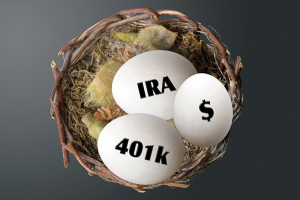IRAs vs. 401(k): Which Is the Best Choice?
By Jim Terwilliger
 Many folks consider IRAs and 401(k) plans to be six of one, half-dozen of the other. Yes, both have tax-deferred and tax-free options. The tax rules for both types of plans are similar.
Many folks consider IRAs and 401(k) plans to be six of one, half-dozen of the other. Yes, both have tax-deferred and tax-free options. The tax rules for both types of plans are similar.
But there are differences that make one a better choice than the other under certain circumstances.
Employer 401(k) plans are super savings vehicles for folks who are working and accumulating money for retirement.
401(k) Benefits Include:
• Much higher ceiling for maximum contributions. This year, the ceiling is $18K or $24K for those age 50 and older. The IRA ceiling is $5.5K or $6.5K for age 50 and older.
• No income limitation for making contributions. The only limitation is the ability to earn enough money to afford the contributions. Depending on a person’s circumstances, the ability to make deductible contributions to an IRA start to be phased out at an income of $61K single or $98K married. For after-tax contributions to a Roth IRA, the phase-out starts at $116K single or $183K married.
• Potential for an employer match. Many employers will match employee contributions up to a certain limit. Depending on the size of the match and employee contribution rate, this can increase the effective return on the investment by a significant margin.
• Ease of use. What could be easier than having your regular contribution come out of your paycheck, just like tax withholding? But in this case, you are paying yourself, not Uncle Sam and Uncle Andy. In addition, most plans now offer target-date funds that gently reduce stock exposure over the years as you approach your target retirement date. This option offers even the novice investor easy access to an outstanding investment solution, as long as one sticks with it and does not let emotions rule in times of market downturns.
IRA Benefits Include:
When transitioning from an accumulation mode to a distribution mode, which happens when moving into retirement, a lot of things change, including the growing attractiveness of IRAs as a tax-deferred or tax-free savings vessel. Some of the advantages include:
• Roth IRA as a rollover receptacle for Roth 401(k) money. This is a no-brainer. Why? Recall that even though a Roth 401(k) is a tax-free account, it does mandate required minimum distributions (RMDs) when you reach age 70-1/2. The only way to avoid this unfortunate situation is to roll the entire Roth 401(k) plan into a Roth IRA where RMDs are no longer in the picture.
• Take a distribution whenever you want. Many 401(k) plans place restrictions on access to your money when you retire. The Kodak plan, for example, allows you to set up a regular monthly distribution. But once established, you cannot stop the distribution or reduce it. You are only allowed to increase it. Further, the plan allows a maximum of four on-demand lump-sum distributions per year. With an IRA, funds are available to you on demand and regular distributions can be started, stopped, increased or decreased depending on your needs.
• Aggregate RMDs among multiple accounts. When you get into RMD territory, you must withdraw from each of your separate 401(k) plans. With multiple tax-deferred traditional IRAs, you can mix and match. Draw your combined RMD from one IRA only, from more than one, or from all. It doesn’t matter.
• Control withholding. Depending on your tax situation and number of accounts, you may wish to establish your own federal withholding levels for distributions, including no withholding at all. You can do that with IRAs but not with 401(k) plans for which 20 percent federal withholding is mandatory.
• Expanded investment options. With a 401(k) plan, investment choices are limited to the menu your employer provides within the plan. Such choices may or may not be overly limiting. Some plans may only offer funds having high internal expense ratios. With an IRA, your investment choices are virtually unlimited.
• Employ a qualified charitable distribution gifting strategy. In my last column, we explored how charitable giving through direct non-taxable IRA distributions to charities can be advantageous, particularly for those in RMD territory who do not need RMDs to satisfy cash flow needs. Such distributions are allowed from IRAs but not from 401(k) plans.
• Work with a trusted adviser. Being able to select and work with the same local adviser, face to face, over your retirement timeframe is a key advantage of converting your 401(k) assets to one or more IRAs. While some employer plans provide assistance to retirees, often such help is at the other end of an 800 number and call-center adviser turnover can be high.
James Terwilliger, CFP®, is senior vice president, financial planning officer at Wealth Strategies Group, Canandaigua National Bank & Trust Company. He can be reached at 585-419-0670 ext. 50630 or by email at jterwilliger@cnbank.com.
